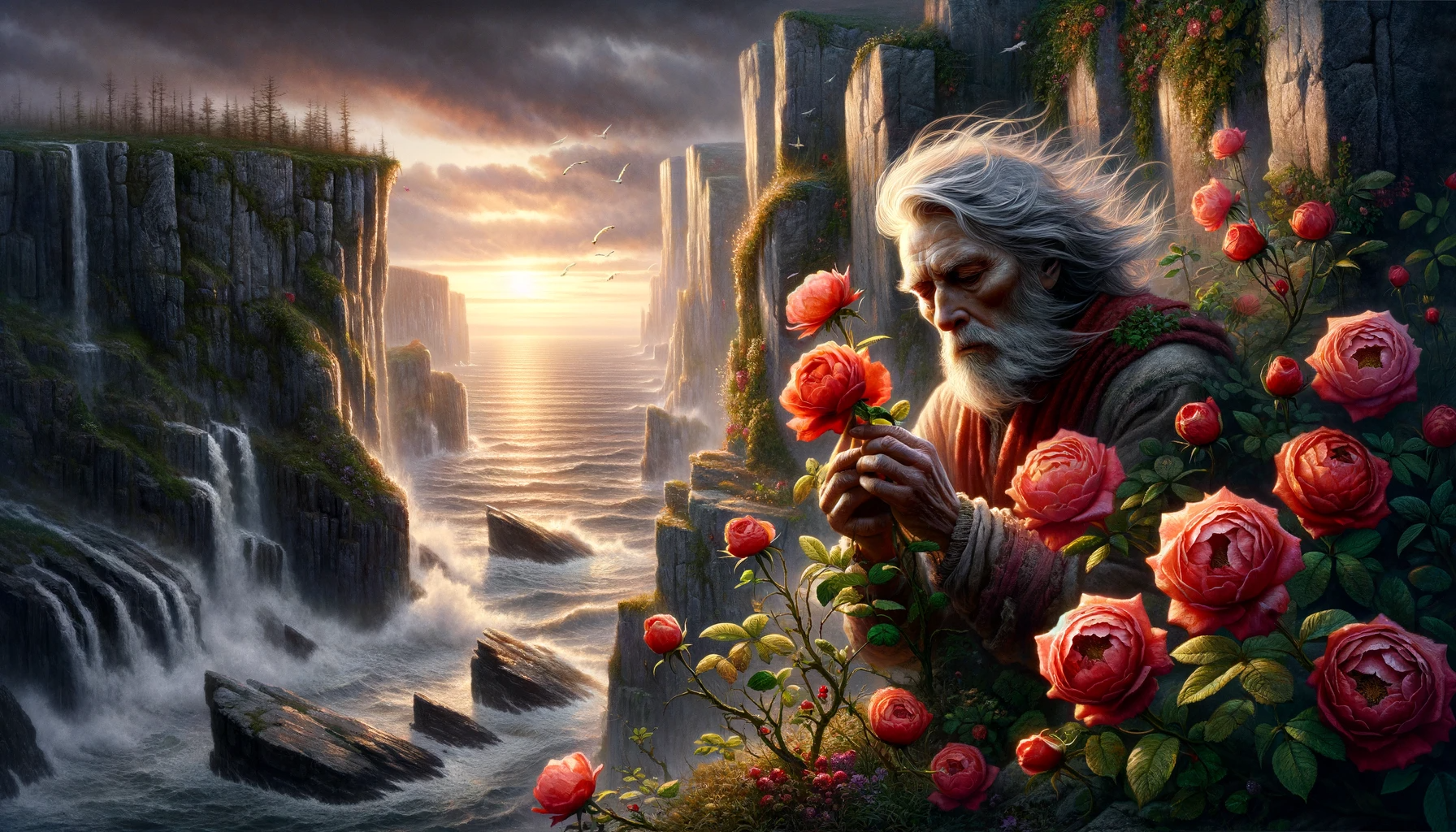Once, in a land of rugged cliffs and whispering winds, there existed a rare phenomenon that drew travelers from afar—the wild roses of the cliff. These roses were not just a spectacle of nature; they were a metaphor for the delicate balance of life, beauty, and sorrow.
The story begins with an old legend, whispered among the villagers. It was said that the roses bloomed only where the tears of the cliff’s guardian had fallen. This guardian was a solitary figure, a woman of ethereal beauty and profound sadness. Her name was Elara, and her story was as captivating as the roses she nurtured.
Elara was once a young maiden, full of life and dreams, in the village nestled at the foot of the cliffs. Her heart, however, belonged to the sea and the mysteries it held. Every day, she would climb the treacherous cliffs to gaze upon the horizon, dreaming of distant lands. It was on one such day that she met Lysander, a sailor whose ship had anchored near the village. Their love blossomed like the wild roses on the cliff—fierce, passionate, and untamed.
But their happiness was short-lived. Lysander had to return to the sea, promising Elara he would come back with the first bloom of spring. Seasons changed, but Lysander did not return. Heartbroken and unable to bear the villagers’ pitying looks, Elara retreated to the cliffs, her only solace.
Years passed, and Elara grew into a woman of sorrow. Her tears, shed for her lost love, watered the barren cliffs. Miraculously, where her tears fell, roses began to bloom, their petals as red as the blood that ran through her aching heart. They were a beacon of beauty in a place of desolation, a symbol of love that endured in the face of loss.
Travelers who came to see the roses often saw Elara, her figure a silhouette against the setting sun, her eyes forever scanning the horizon. They said the roses bloomed brighter with each tear she shed, a poignant reminder of the love she held for Lysander.
Decades later, an old sailor came to the village. His eyes, weathered by the sea, held a familiar spark. It was Lysander, returned at last, his heart heavy with the weight of a promise unfulfilled. He climbed the cliffs, following the trail of roses, hoping to find Elara and beg her forgiveness.
At the cliff’s edge, he found her, her hair now silver like moonlight, her beauty untouched by time. Their eyes met, and in that moment, years of longing and sorrow melted away. But fate, as cruel as it can be kind, chose that moment to take Elara away. With a final smile, she whispered Lysander’s name and slipped away, her spirit joining the sea she so loved.
Lysander, now the guardian of the cliff, tended to the roses that were a testament to their undying love. The villagers say that on nights when the wind is gentle and the sea calm, you can hear Lysander’s whispers in the rustling leaves of the roses, telling Elara of his adventures, his voice tinged with an eternal sorrow.
The wild roses of the cliff thus remain, blooming in solitude, a reminder of a love that transcended time, and of the delicate balance between joy and sorrow, life and loss. In their ephemeral beauty lies a story of love, longing, and the resilience of the human heart.
As the years rolled on, the legend of Elara and Lysander, and the wild roses of the cliff, became deeply ingrained in the fabric of the village. The roses, with their thorny stems and velvet petals, stood as a monument to enduring love and the inexorable passage of time.
Lysander, now an old man, spent his days tending to the roses. With each bloom that opened to the sun, he felt a connection to Elara, as if she were still there with him, in the whisper of the wind and the fragrance of the flowers. The villagers, who once pitied him, now respected him as the keeper of a sacred tradition.
As the guardian of the roses, Lysander began to understand the deeper symbolism of the flowers. They were not just a reminder of his lost love but a metaphor for life itself. The cliff, with its harsh conditions and unyielding rock, represented the trials and tribulations everyone faces. The roses, blooming in such an unlikely place, symbolized hope, resilience, and the ability to find beauty in the midst of hardship.
Over time, the story of the wild roses attracted artists, poets, and dreamers from all over the world. They came to witness the miraculous blooms and to seek inspiration from the story of Elara and Lysander. The roses became a muse for artworks, poems, and songs that spoke of love, loss, and the enduring strength of the human spirit.
But even legends come to an end. Lysander grew frail, and he knew his time as the guardian was coming to a close. In his final days, he was often seen talking to the roses, as if imparting his life’s wisdom to them. When he passed away, the village mourned, but they knew that his spirit would forever be a part of the cliffs and the roses he had loved so much.
After Lysander’s passing, the villagers took up the task of caring for the roses. They understood that the roses were more than just flowers; they were a legacy, a living story passed down through generations. Each year, on the anniversary of Elara and Lysander’s meeting, the village held a festival. They celebrated the enduring power of love and the beauty that can arise from grief.
The wild roses of the cliff continue to bloom, year after year, their beauty undiminished by time. They remind those who gaze upon them that even in the face of loss and sorrow, there is beauty and strength. The roses whisper a message of hope to those who listen: In the toughest of environments, against all odds, love and life can thrive.
And so, the wild roses on the cliff bloom, not just as flowers, but as a timeless metaphor, a tribute to the human heart’s capacity for love, resilience, and the finding of beauty in the most unexpected places.
The story of the wild roses on the cliff, like all great tales, transcended time and space, weaving itself into the hearts and minds of people far beyond the small village. As the years turned into decades, the story evolved, each retelling adding layers to its already rich tapestry.
In the village, the roses became a symbol of communal identity and pride. Children grew up listening to the tales of Elara and Lysander, learning about the roses’ resilience and the importance of nurturing beauty in unexpected places. The festival, initially a small, local affair, grew into a significant event, drawing visitors from distant lands. People came not only to see the blooms but also to participate in the celebration of love and perseverance.
The festival became a colorful tapestry of art, music, and storytelling. Musicians composed ballads that echoed the tragic yet hopeful love story. Artists created paintings and sculptures inspired by the roses, each piece reflecting the unique interpretation of the artist. Storytellers, both young and old, gathered around bonfires, their tales keeping the memory of Elara and Lysander alive in the flickering flames and the starlit skies.
But the impact of the wild roses extended beyond the realm of art and culture. Botanists and nature enthusiasts were drawn to the cliffs, marveling at how the roses thrived in such a harsh environment. They studied the roses, hoping to understand their resilience and adaptability. The roses became a subject of scientific interest, a natural wonder that held secrets to survival in extreme conditions.
As the world outside the village changed, with technology advancing and societies evolving, the story of the wild roses provided a constant, a reminder of the enduring power of nature and emotion. The story became a symbol of hope for those facing adversity, a beacon for those lost in the complexities of modern life.
Generations came and went, and with each, the legend of Elara, Lysander, and the wild roses was passed down, its core message remaining unaltered even as details were added or forgotten. The roses themselves became guardians of history, each bloom a repository of stories, a witness to the passage of time.
In the end, the wild roses on the cliff stood for something profound and universal. They symbolized the human experience—the joy, the pain, the love, and the loss that everyone inevitably faces. They were a reminder that even in the harshest of environments, beauty and life can flourish. And most importantly, they were a testament to the fact that stories, like love, transcend time, living on in the hearts of those who hear and tell them, blooming eternally in the garden of human memory.


The wild roses symbolize enduring love and resilience, blooming from Elara’s tears and unyielding spirit. 🌹💔